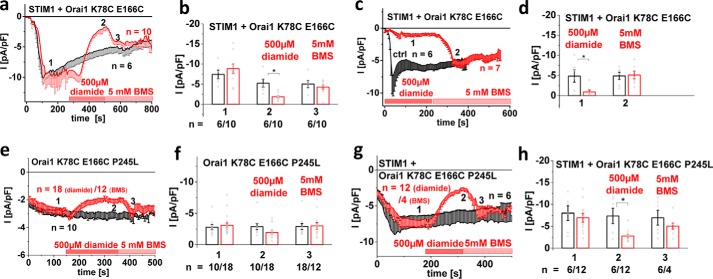Figure 7.
Cysteine cross-linking of NT and loop2 of Orai1 reduces STIM1-mediated currents significantly. Throughout the figure, black corresponds to untreated cells, and red corresponds to treated (with diamide/BMS) cells. a, time course of whole-cell inward currents at −74 mV activated upon passive store depletion of HEK 293 cells co-expressing STIM1 + Orai1 K78C/E166C. Upon maximal activation of STIM1-Orai1 K78C/E166C currents, cysteine cross-linking was induced via diamide (500 μm), and the subsequent release of disulfide bonds was induced via BMS (5 mm). b, bar graph comparing currents at the respective time points 1 (after maximal activation upon passive store depletion), 2 (after application of diamide), and 3 (after application of BMS). c, time course of whole-cell inward currents at −74 mV activated upon passive store depletion of HEK 293 cells co-expressing STIM1 + Orai1 K78C/E166C pretreated with diamide (500 μm). After 230 s, BMS (5 mm) was applied to release disulfide bonds. d, bar graph comparing currents at the respective time points 1 (after maximal activation upon passive store depletion in the presence of diamide) and 2 (after application of BMS). e, time course of whole-cell inward currents at −74 mV activated upon passive store depletion of HEK 293 cells expressing Orai1 K78C/E166C/P245L. Upon maximal activation of Orai1 K78C/E166C/P245L currents, cysteine cross-linking was induced via diamide (500 μm), and the subsequent release of disulfide bonds was induced via BMS (5 mm). f, bar graph comparing currents at the respective time points 1 (after maximal activation upon passive store depletion), 2 (after application of diamide), and 3 (after application of BMS). g, time course of whole-cell inward currents at −74 mV activated upon passive store depletion of HEK 293 cells co-expressing STIM1 + Orai1 K78C/E166C/P245L. Upon maximal activation of STIM1-Orai1 K78C/E166C/P245L currents, cysteine cross-linking was induced via diamide (500 μm), and the subsequent release of disulfide bonds was induced via BMS (5 mm). h, bar graph comparing currents at the respective time points 1 (after maximal activation upon passive store depletion), 2 (after application of diamide), and 3 (after application of BMS). *, p < 0.05; error bars, S.D.

